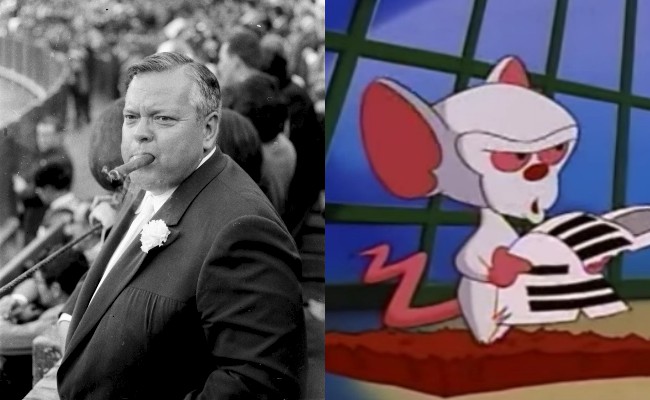While Nickelodeon was creating history with powerhouse animated series in the mid ’90s, Warner Brothers’ Kids’ WB held its own with original cartoons born from visionary producers and directors.
With the success of the network’s Steven Spielberg-produced Animaniacs, the team tried to re-create their triumph with a spin off about the series’ two genetically spliced mice, Pinky and the Brain. Airing from 1995-1998 (and leaving the airwaves 18 years ago today), Pinky and The Brain followed the enhanced test subjects through their joint efforts to “take over the world.”
After a short run, the show was rebranded with another character, Elmyra, to achieve a more sitcom-like vibe, but the adult humor and witty parody of the original series was ultimately lost. From the involvement of iconic historical figures, to the hilarious ‘Odd Couple’ relationship of the main rodents, Pinky and the Brain was truly one of a kind in its original form. Here’s some things you might not have known about the series.
Pinky and the Brain are both based on real people.
Pinky and the Brain were inspired by real people – not real mice, real people. The show’s producer, Tom Ruegger, was once struck by the idea of two of his Tiny Toon Adventure co-workers attempting to take over the world.
Artist Eddie Fitzgerald and Tom Minton were well known as oddballs around the office – so much so, that Ruegger decided to model his animated stars after them.
Even some of Pinky’s phrases come directly from his inspiration: Fitzgerald constantly said things like “narf” and “egad.”
But Brain is basically also Orson Welles.

Maurice LaMarche, the Emmy-award winning voice actor behind the Brain, has lent his vocals to a slew of characters over the years, including Futurama‘s Kif Kroker. The character he’s played most repeatedly, however, is not a character at all.
LaMarche’s Orson Welles impression is so uncanny, that he’s rolled it out for many programs. And it even crept it’s way into the characterization of the Brain.
“I always say, ‘The Brain isn’t Welles,’ ” LaMarche told the AV Club. “The Brain is 70 percent Welles, 20 percent Vincent Price, and I don’t know, there’s another 10 percent of something else in there. I don’t know what. Some people think it’s Peter Lorre. I don’t know what it is. So I don’t think of Brain as Welles, but people do.”
The show even went as far as to recreate Welles’ infamous frozen peas commercial debacle nearly line-for-line. In the Pinky and the Brain iteration, most of Welles proclamations are included verbatim, via the Brain, while Pinky serves as the director.
The show was scored by a 40-piece orchestra.
As was par for the course with all of the WB’s animated programs at the time, Pinky and the Brain, was scored by a complete orchestra. The size ranged per episode from between 30 and 40 members, who were led by Emmy-Award winning composer Richard Stone.
All the recordings were done on the Warner Bros. lot, with a revolving door of other composers and conductors like Julie Bernstein lending their talents to what was considered by many a revival of Carl Stalling’s composition work on Looney Tunes.
The series won a PRISM Award for an episode.
Remember those poorly-produced health class videos about smoking and drug use? Pinky and the Brain‘s “Inherit the Wheeze” episode was like that, but better. And funnier. So much so that it won an award for properly getting across an anti-smoking message.
“Inherit the Wheeze” won the 1999 PRISM Award in the Television Children’s Animated Series Episode Category. What’s a PRISM Award? Then only in its third year, the honor was bestowed upon those in the entertainment industry that used their medium to “accurately depict drug use and addiction.”
In the episode, Brain was subject to the effects of smoking by a tobacco company. Other ’99 winners included ER and Sports Night.
The theme song is a spin on “Singing in the Rain.”
In 1952, the wonderful Gene Kelly swung around on lamp posts and danced his way into pop culture history with the title track from movie musical Singing in the Rain.
In 1995, two mice plotted world domination on a children’s show to the same tune. Composed by Stone and with lyrics by Ruegger, Pinky and the Brain‘s theme song had a startling amount of similarities to “Singing in the Rain” – because it was basically the same song.
“Originally, Tom was singing the lyrics to the melody of ‘Singing in the Rain.’ Try it,” Hastings revealed in the aforementioned forum post.
“I’m singin’ in the rain / Just singin’ in the rain” versus “They’re Pinky and the Brain / Yes Pinky and the Brain.” See?
There’s a reason Pinky sounds like a member of Monty Python.
Rob Paulsen (Pinky) totally loves Monty Python. He loves them so much it landed him a job.
“In the early ’70s I was a huge ‘Monty Python’ fan. That’s where I got my love of satirical, oddball humor and dialects,” he said during a 2012 interview.
When auditioning for the role of Pinky, he was struck by the idea that the dimwitted mouse might sound like some of his British comedy icons.
“I thought it might be interesting to have Pinky have this weird British accent,” Paulsen said. “He’s got this terrible overbite, and he’s clearly the stupider of the two. They really seemed to like that English thing, even though it wasn’t what they had in mind initially, and Mr. Spielberg thought it worked. And it was an iconic role for me.”
